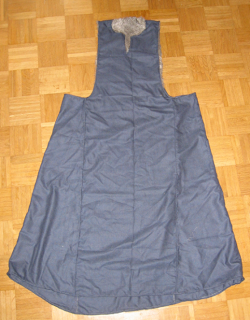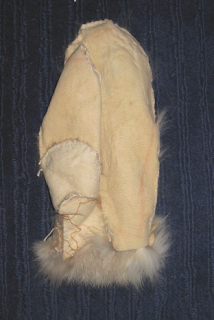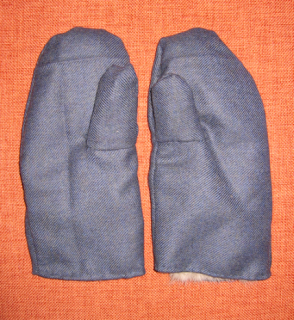Handsewn

or machine sewn? For normal modern people, that is no question - a machine is faster and will almost guarantee you even, smooth stitches. When going into the living history field, things are different - machine sewn garments are then a sacrifice to modern style, to laziness, or to the fact that nobody has enough time for all those enticing projects and all the clothes needed. Or is that so?
When I started sewing for living history events, I was seventeen years old and had just gotten into the "medieval market" scene. My first piece was a hood - what else? It took me ages to stitch together the two halves of a hood (cut after a pattern drawing in a journal, not after an archaeological find). Even worse, the cloth was a mix of wool and polyester. But I had my first deep experience with hand-sewn clothing then, and I found that it really makes a difference.
Unlike modern patterns for clothing, medieval patterns are not designed with a sewing machine in mind. On the other hand, sewing technique is such an important thing in medieval tailoring that fabric, sewing thread and seam type were carefully matched together to get best results - this can be seen when comparing the extant medieval garments.
Choosing the right fabric for a pattern, and the right seamtypes for that fabric, is an essential part of historical tailoring and sewing. Which already answers part of the question that I hear regularly:
Why do you sew by hand?Historical patterns are not designed for sewing with a machine. Many stitches cannot be reproduced with a common household sewing machine at all (and not even a high-end one). In addition to that, hand stitches are much more versatile than machine stitches, and the beauty and functionality of good hand stitching are astonishing. On the Viborg Shirt*, up to eight layers of fabric are stitched together into a join that will lie absolutely flat - and this is even possible with thick, homewoven old linen. A hand-sewn seam will always look, fall and drape differently than a machine seam. And last but never least, it is much sturdier - as everyone who has ever picked a hand-seam apart will know.
Sewing by hand does of course take much longer than just running it through the machine. For an authentic presentation, however, handsewing is essential, and I can promise each hopeful beginner that he or she will have a wholly different attitude towards the hand-sewn garments, compared to something quickly machined together.
Here's a picture to whet your appetite for hand-sewn garments: It is one of my reproductions of St. Elisabeth's dress, sewn with linen thread from medium-thick wool twill. The hem is finished with a double row of running stitches and overcast stitching with inlaid wool yarn. Isn't this a nice thing to behold?
 *
* There is a very thorough article on the shirt by
Mytte Fentz
, "En hørskjorte fra 1000-årenes Viborg" in KUML 1987; Årbog for Jysk Arkælogisk Selskab







